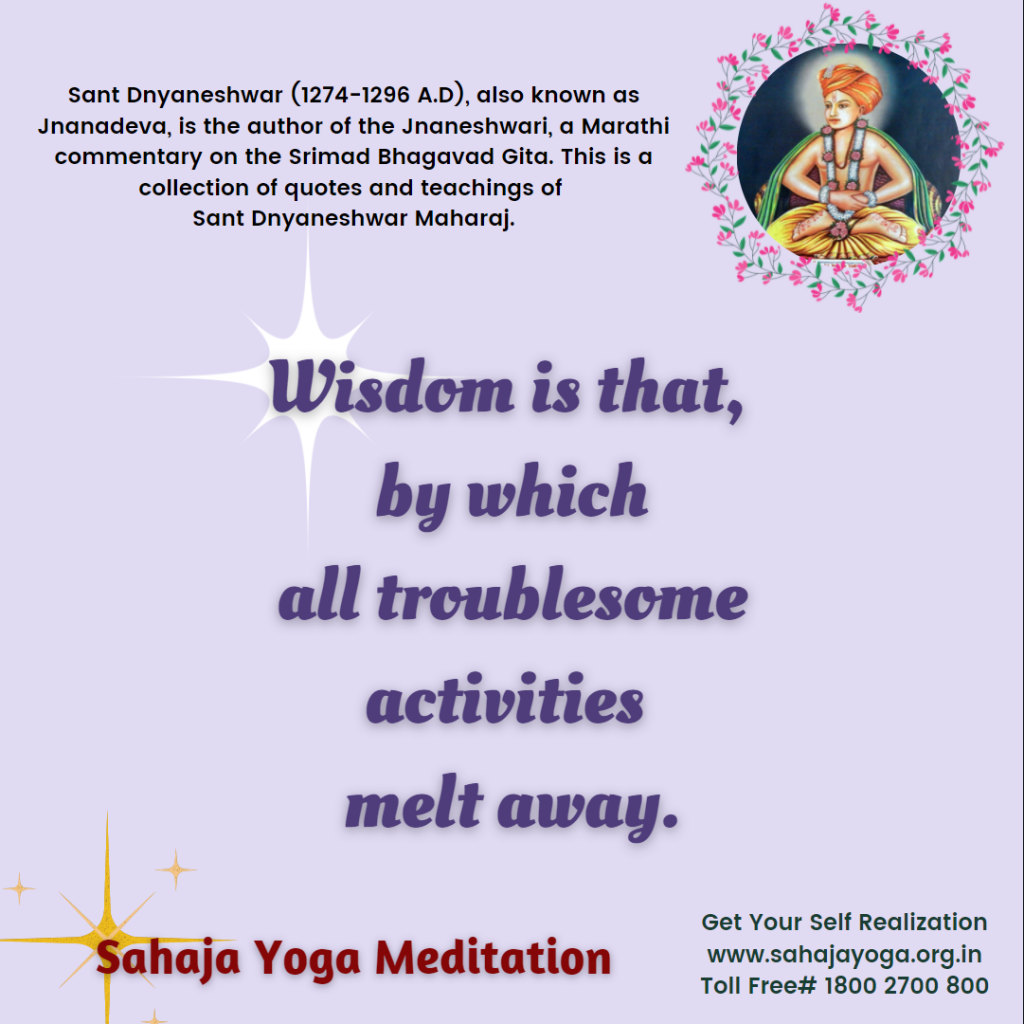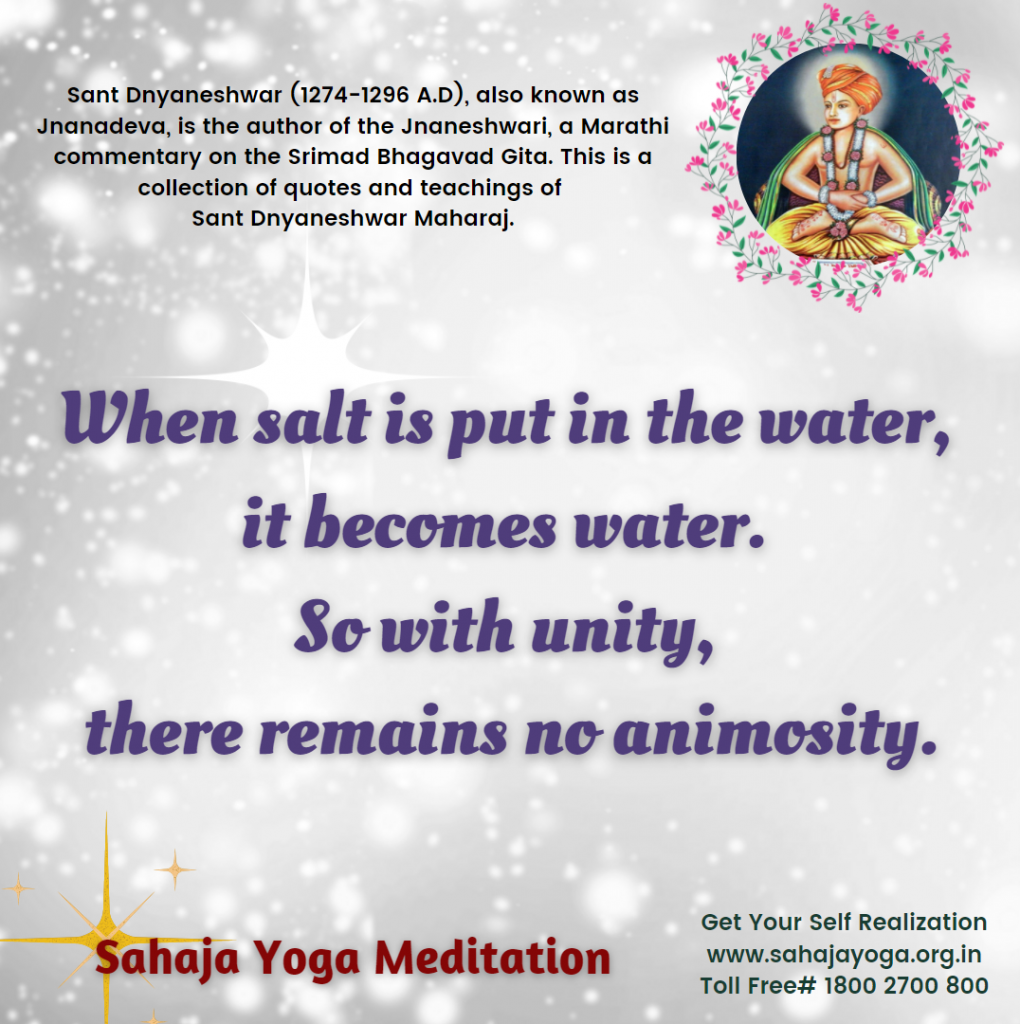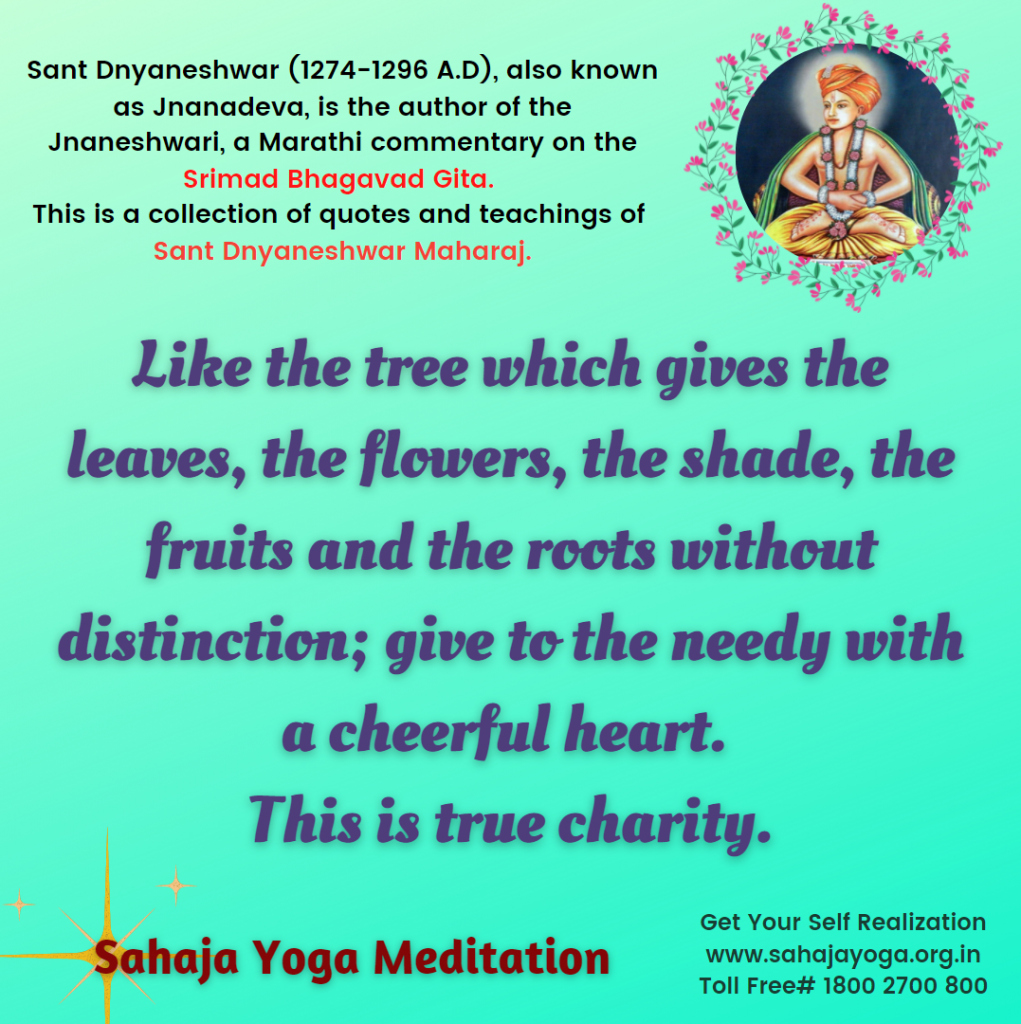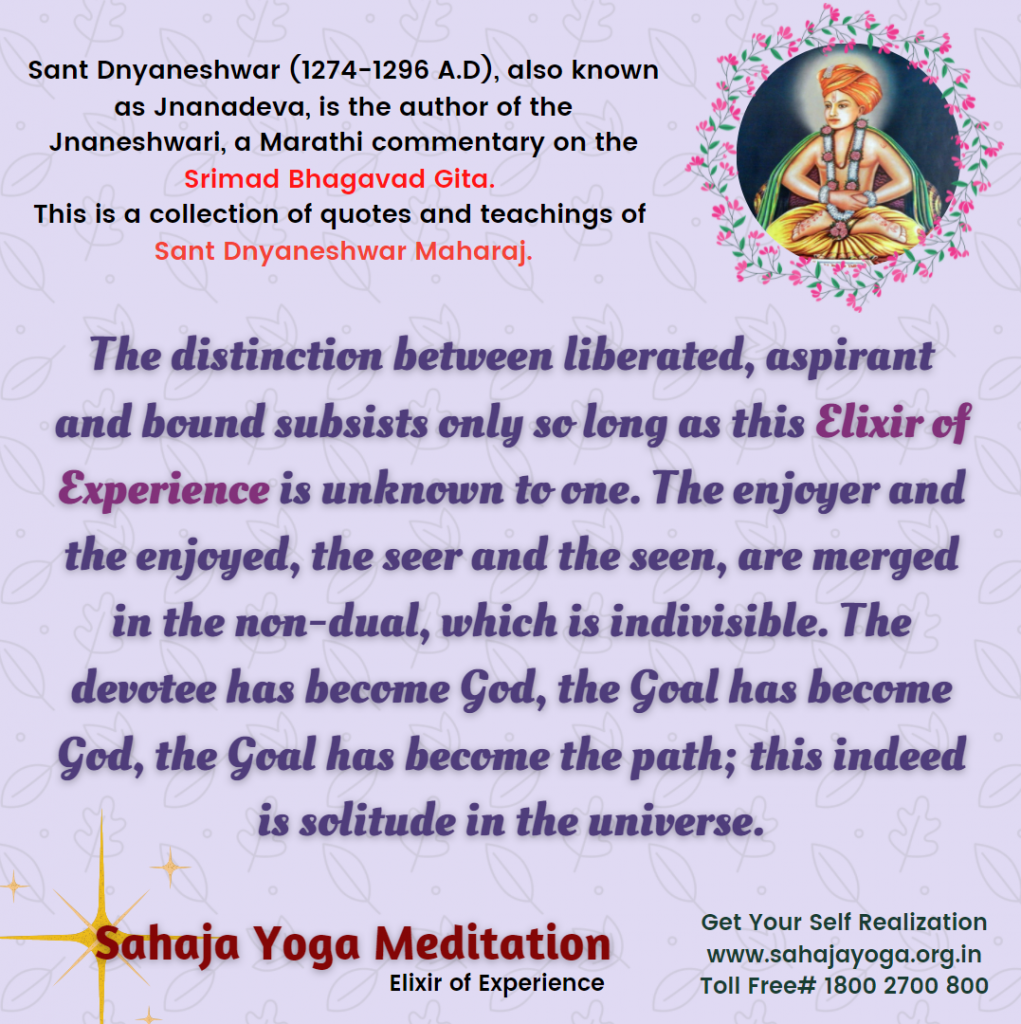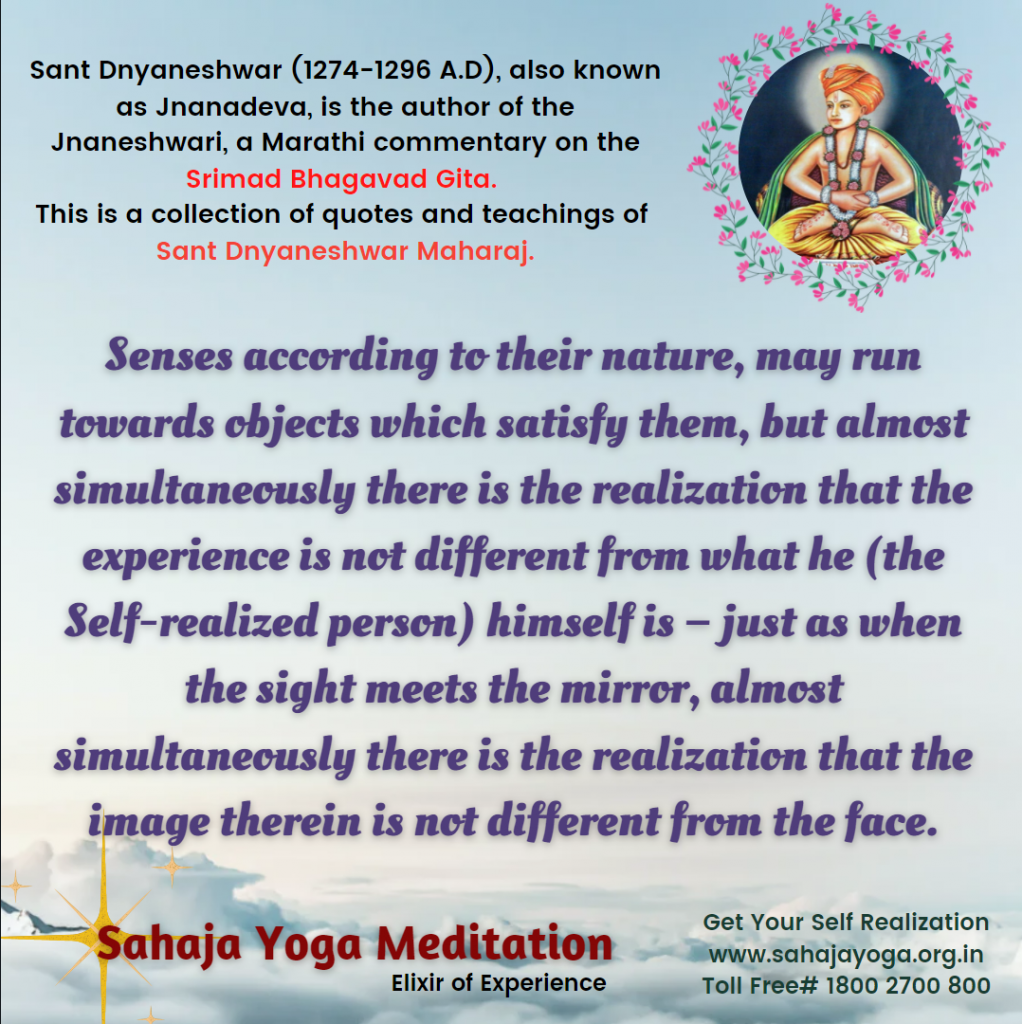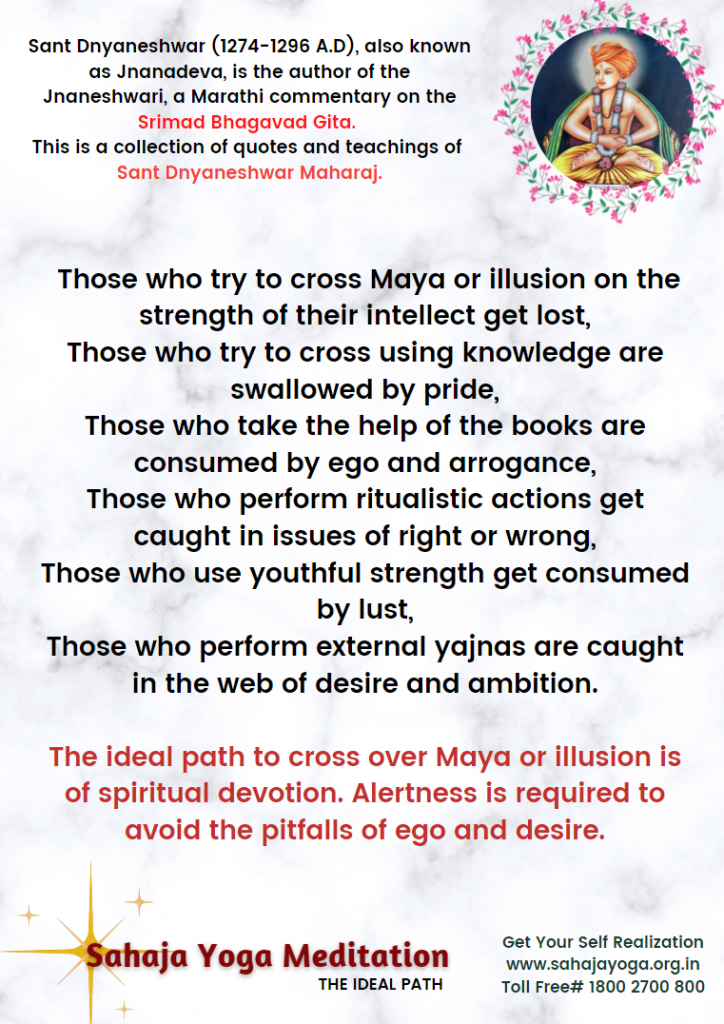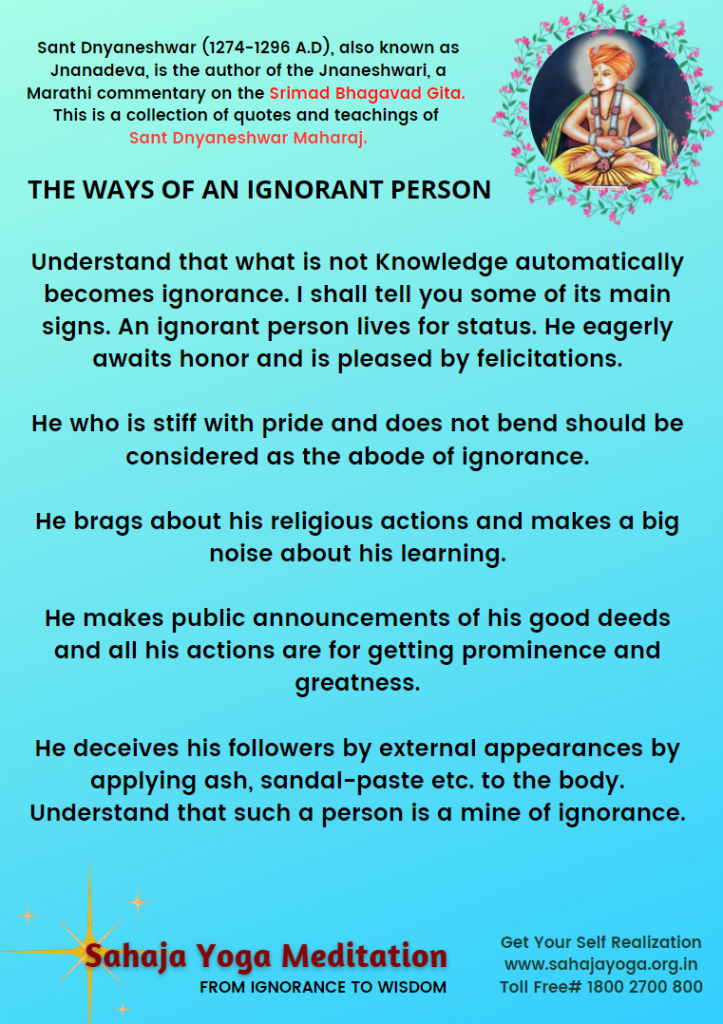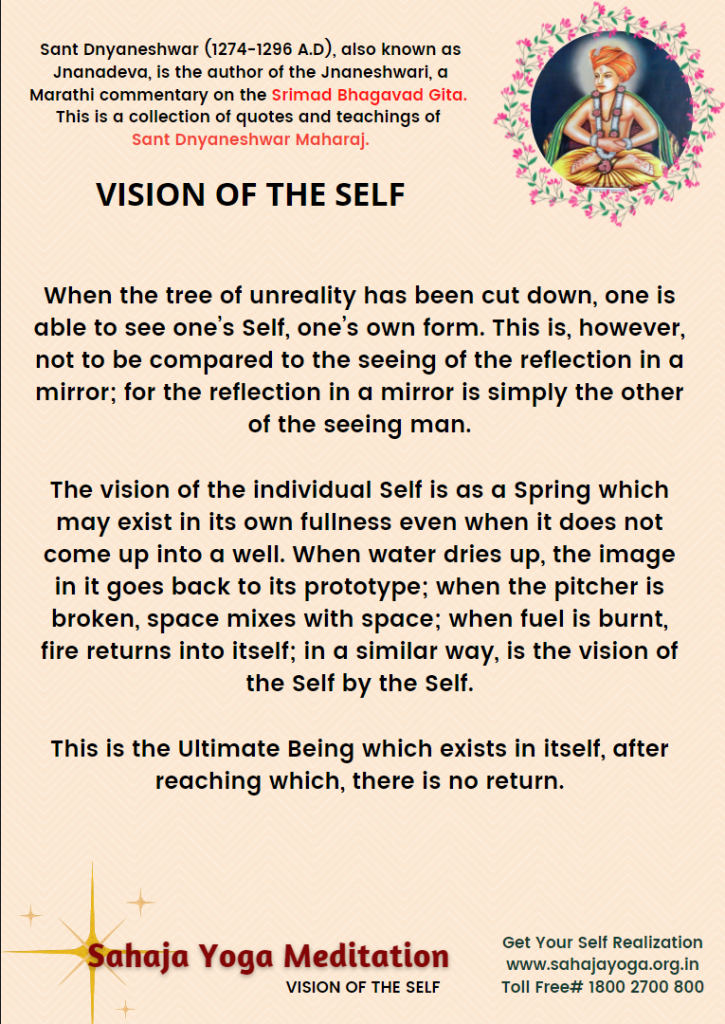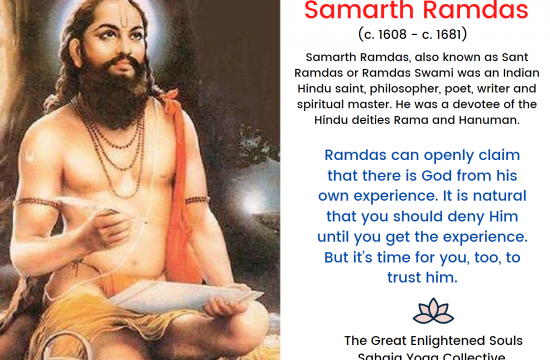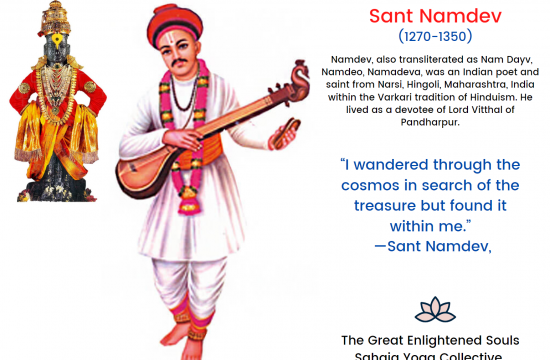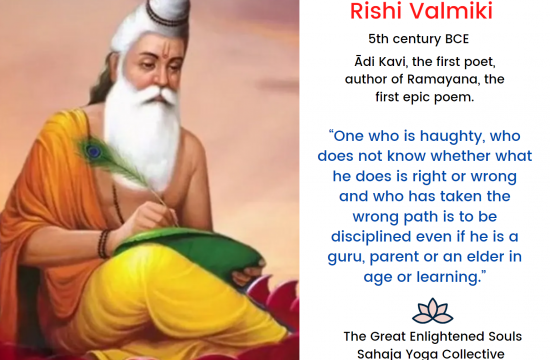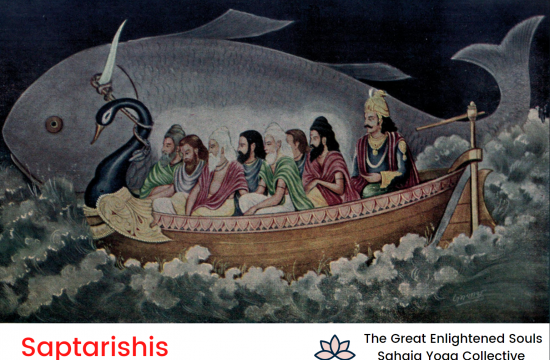Sant GNYANESHWAR, (1275-1297A.D.)
Some 20 Kilometres from Pune is a quaint little village of Alandi where by an Ashwattha tree is situated a Maruti Mandir. Pilgrims, ascetics and Saints often took rest here and the villagers warmly catered to their needs. A young woman by the name of Rukminibai deserted by her husband Vitthalpant had taken to an austere life. She would pass her days praying at the temple and serving the holy men. One evening as in a normal course she bowed down at the feet of an ascetic named Ramananda. The ascetic, seeing the red turmeric mark of a married lady on her forehead, bestowed upon her the auspicious benediction of a son.
Tears rolled down the cheeks of the grief stricken Rukminibai as she could not contain the sorrow of the impossibility of the situation. The compassionate Ramananda thereon enquired of Rukminibai the course of her grief and learnt that her husband Vitthalpant had deserted her to become an ascetic. It suddenly dawned upon Ramananda that a recently initiated disciple calling himself ‘Chaitnyashram‘ was none other than the runaway Vitthalpant, husband of Rukminibai.
On returning to Banaras, Ramanda severely reprimanded Vitthalpant for concealing his marital status and sent him home. He was guilty of both deserting an issue less wife and of renunciation without her consent.
Thereafter, Vitthalpant resumed his family life. However, as it was unheard of for an ascetic to resume family life, the Brahmins of Alandi socially boycotted the Vitthalpant family. Vitthalpant begot three sons and one daughter. When the boys come of age it was customary to initiate them in the Brahmin fold by a thread ceremony. The Alandi Brahmins refused to initiate them and the despondent Vitthalpant left for pilgrimage to Trimbakeshwar along with his family.
Once during their visit to the jungle, they sighted a tiger leaping towards them. They ran helter skelter for protection and in that confusion the eldest son Nivrittinath lost his way and found himself in a Mountain cave. The cave happened to be inhabited by the great Nath Yogi Gahininath. The great yogi initiated the tender lad of 7 into the tradition of the Nath Sect and then sent him back to his family to spread the work of world salvation.
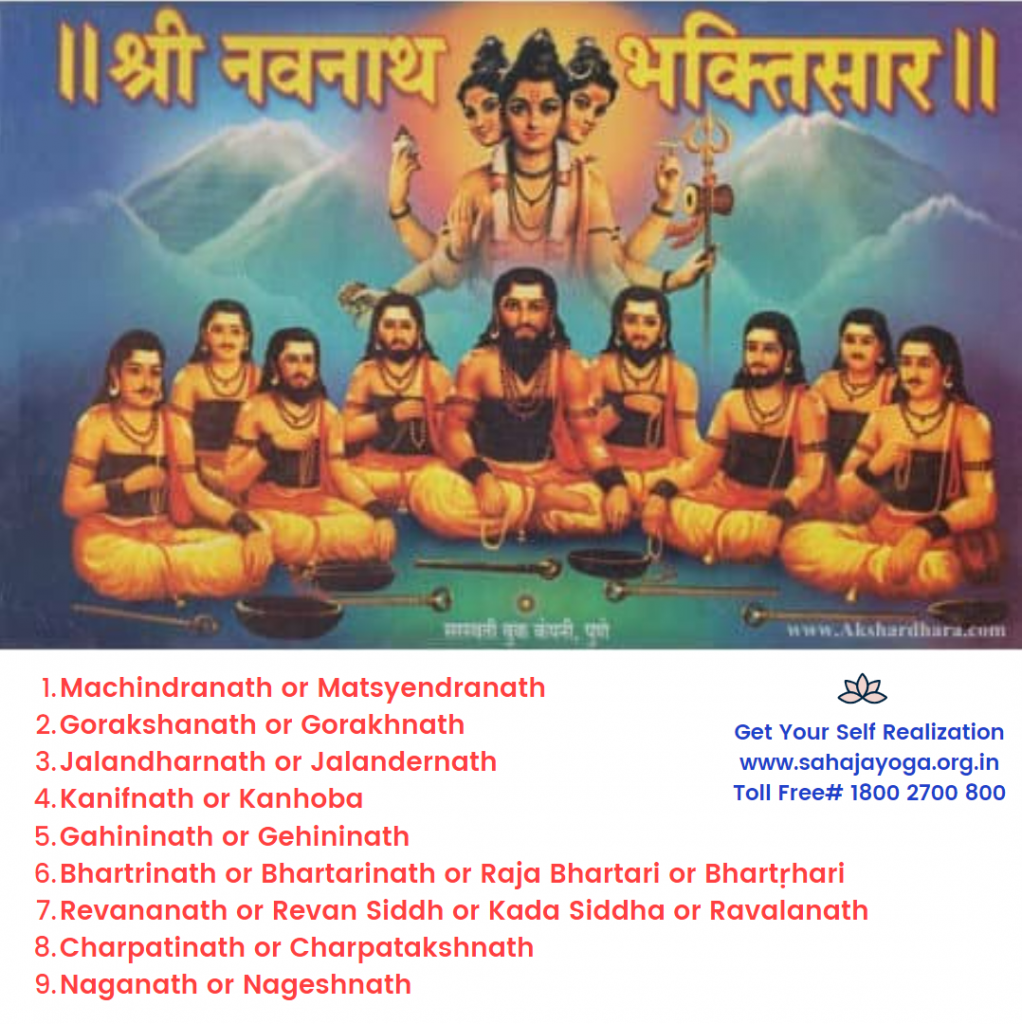
The Nath Sampradaya is a lineage of nine masters (Navnath) who trace their origin to the Primordial master, known as the Adinath. They transmitted the knowledge of the kundalini from one master to a disciple secretly. They perceived that man was a victim of his mind, and unless he became the spirit he could not break through the bondage of the senses. Only the guidance of an enlightened master called Nath could pull them out of the illusion created by the mind. They revealed that God consciousness did not lie outside the human body but in the thousand-petalled lotus – the Sahasrara, in the limbic area of the brain. To ascend to this level, the lower six centres have to be awakened by the perennial energy known as the Kundalini, which resides within the Sacrum bone. When the Kundalini is awakened in the Sahaja way, it ascends through a subtle path called the Sushumna Nadi which runs along the spinal cord.
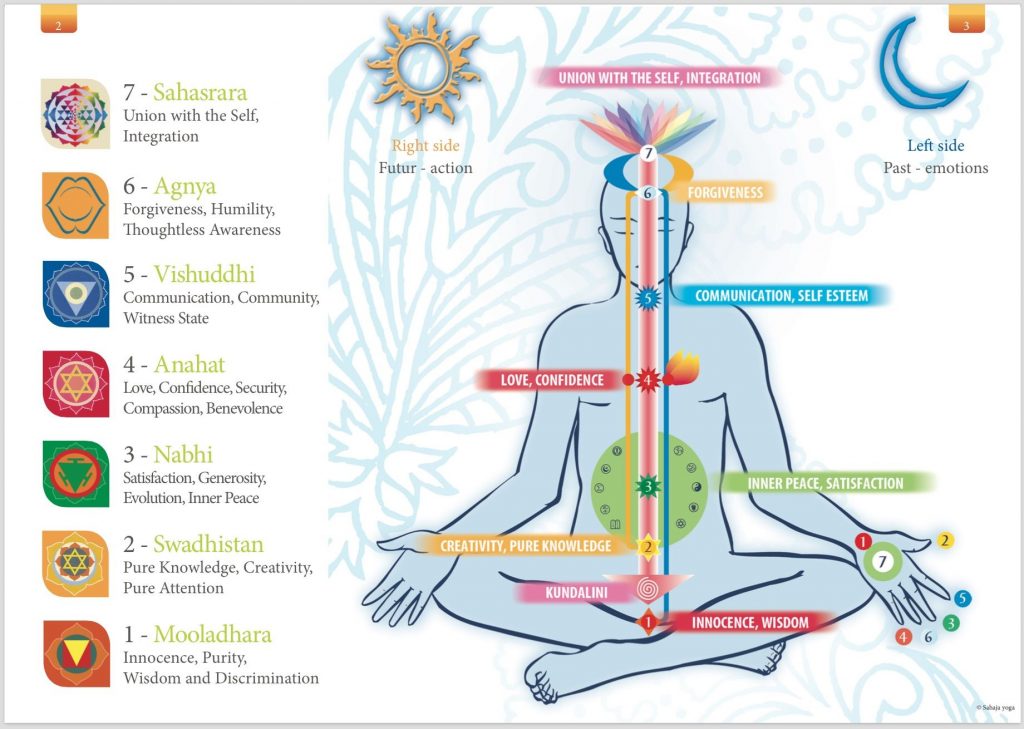
When the Kundalini pierces the thousand petal lotus, it releases an Elixir that gives divine bless and also leads to the experience of collective consciousness. Moreover, it rejuvenates the body and cures all ailments.
Nivrittinath passed on the knowledge to his brother saint Gyaneshwar , and the children become authorities in spiritual matters. However, the stigma of the irregularity of Vithalpant’s marriage attached to his children kept haunting him and at the insistence of the Brahmins, he and his wife atoned by drowning themselves in the holy confluence of the Ganga and Jamuna at Prayag. But the Brahmins still refused to perform the thread ceremony of the three sons, directing them to appeal to the Brahmins of Paithan.
Gnyaneshwar with his two brothers and sister proceeded to Paithan where he stunned the unwilling Brahmins by his spiritual powers. In a philosophical argument, Gnyandeo’s claim of equality for all God’s creatures was countered by an opponent, who, by pointing to a buffalo, challenged Gnyandeo to make it chant Vedas. It was no sooner said than done and the Brahmins had to consent.
On his way back from Paithan he felt impelled to translate the Bhagwad Gita in Marathi. He stayed on the bank of the River Prawara in Ahmednagar District and wrote the Gnyaneshwari – a commentary on the Bhagwad Gita in Marathi. He was barely fifteen years old, later he wrote another philosophical work, Amritanubhava. In his translation of the Gita he gives a very lucid account of the inner working of the Divine mechanism.
He reveals that at the base of the spine rests the Divine energy force called Kundalini which abides in a sleeping condition in three and a half coils, appearing brilliant like a roll of fire flames.
“The Goddess Kundalini is verily like the very Mother of the Universe, as also the grandeur of the Supreme Majesty of the Soul…. she is the very seat of the great naught.”* .
When it gets awakened it rises through the central channel called Sushumna and pierces the Brahmarandhra (the fontanel bone area) in which abides the sentience without any substratum. He described the ascent of the Kundalini through Chakras which are plexuses formed by nerves and ganglia along the spine.
These rise one above the other and are linked together. They are in order of ascent; Mooladhara, Swadishthana, Manipura, Anahata, Vishuddhi, Agnya and finally the Sahasrara.
“The Kundalini retains its power until it is absorbed in the Supreme Brahma ‘making itself steady in the Brahmarandhra
and embraces the Supreme (Brahman)… just as the sea water becomes pure through the clouds, pours itself down into the river and ultimately rejoins the sea, in the same way the individual soul, with the help of the human form, enters into the supreme and becomes one with it…’ “The life wind emerging out of the Kundalini creates a cooling sensation in the body, internally and also externally.”
Gnyaneshwar revealed this secret knowledge to only close disciples as the common man was not yet ready to receive it. Perhaps this knowledge was to be revealed by a Divine Incarnation in modern times, Her Holiness Shri Mataji Nirmala Devi who gives en masse awakening of the Kundalini and whose unique Sahaja Yoga crystalises the knowledge of the Chakras and gives the first-hand experience of the cool vibrations described by Gnyaneshwar as the ‘cooling life-wind’.
Gnyaneshwar attributes the creation of the world to the Supreme Reality ‘Siva’, His manifestation as “Shakti, and the creation of the world by her in myriad of forms and shapes including the human being. The human being is bestowed with the faculty to experience his Divine union and enjoy abiding in it. Basically, Siva (The absolute static), Shakti (its active state) and the world created by them are not three different entities as they appear to be, but are one and the same.
“Both Siva and his beloved Shakti lived as a happy couple, Shakti feeling embarrassed in moving about with her formless husband, covered him a multicolored robe of the universe…” For the understanding of the common man, Gnyaneshwar explained, “The finite self is really Brahma, the universal self. He is therefore really free from the miseries of births and deaths. But he suffers them through ignorance of the true nature of Brahma. He identifies himself with the body and imagines that he is born or he has to die when it is really the body which is born and dies. This state of intuitive experience is called ‘self-perception!’ but this self-perception is not a state of mind wherein self is an object of the perceptive process. The self is the knower and who can know the knower?
Self-perception means ‘being self’, not knowing or perceiving it as a distinct separate object. But though Brahma itself becomes the visible world and being itself, itself its seer, enjoys it. Its unity is not in the least, disturbed by this, as the unity of the original face is not disturbed through its reflection in a mirror. “Just as water plays with itself by assuming the form of waves, similarly the Absolute is playing with itself by becoming the world. There is no duality between the sun and his rays when he is surrounded by the rays. The unity of the moon is not disturbed, even when enveloped by the moonlight. The lotus remains one even when it blooms into a thousand petals. Similarly, there is no difference in Absolute, when it presents itself either as the seer or the world that it sees; for it is the Absolute alone that becomes both.”
It is the discipline of the sense-organs, not their destruction that he advises. His doctrine is of temperance and moderation.
“There is no merit in renouncing the pleasures of this world with the false expectation of a better deal in the next.”
In Gnyaneshwari (V-20), he refers to a sanyasi in the following terms: “He is a true sanyasi who has completely forgotten ‘I’ and ‘Mine’. What is to be given up is the ‘ego-sense’. When that is given up, there is no harm in continuing a family life. When fire is extinguished and coal burnt to ashes, there is not the least possibility of a piece of cotton getting burnt even though surrounded by flames. Similarly, a man may be surrounded by a tempting environment but it ceases to have an effect on him once he is detached. Such a man may be married and own a house, have a big family, yet he can be internally a renouncer.”
“Karma binds, is but a half-truth; Done in the proper way, knowing fully well what it is that binds, karma itself becomes an instrument of freedom. For instance, poison kills is well-known, but it is equally true, that if used in preparing medicine, it saves life. Likewise food nourishes, but if taken in excess brings disease.”
An enlightened master himself, Gnyaneshwar was well aware of the difficulties in the way of common people to practice meditation. He recommended the path of devotion and spent his short life preaching it: “Merely by singing the Lord’s praise, heals the miseries of the world and makes it resound with the purest bliss of the self.”
He does not differentiate between the path of Karma (Performance of one’s duty), Bhakti (devotion) and Gyana (knowledge). These are only three stages on the same path, one leading to the other. The Warkari sect which he consolidated is based on this synthesis. Even idol worship performed with the consciousness of the symbolic nature of the idol finds its proper place in it.
Gnyeshwar recommended both the worship of Hari (the God of the Vaishnavas) and Hara (god of the Shaivas). While advising pilgrimage on penance, he says “you may select Hara or Hari whomever you love” (Dn. XVII-200). Himself a follower of the Nath sect whose originator was Adinath, i.e. Shiva, he selected Gita, the work of Vishnu, for spreading his gospel of infinite bliss. The ‘Vithoba’ of Pandharpur is supposed to hold Shiva on his head (as mark of respect). Gnyaneshwar preached the identity of the two gods in fact, oneness of God;
“A wick in contact with the flame of the lamp itself becomes a flame, a source of light to other flames and no
distinction between the lighting and the flames remains. I am by the grace of Guru – a finite that has become infinite.”
Gnyaneshwar maintained that the individual good cannot be determined without also determining the social good, for a man apart from society is an abstraction, man cannot be conceived apart from society. Man is born in a family and that family itself is a part of the society. He envisioned a state of collective consciousness.
Though himself a celibate he glorified family life and a dutiful chaste woman; “A dutiful chaste woman who does her duties to her family and enjoys and suffers in that, does true penance and gains the merit of an ascetic.” (Dn. XVIII-908)
Gnyaneshwar believed if both the white collared and the menial did their respective duty as service to God, they would succeed in establishing a qualitative equality. Both, in their own way, will be obeying god and equally receiving His grace.
Hence both earn the same kind of merit. In a machine, a small screw is as important and useful as other bigger parts. Similarly, in a society even the smallest man has a function and therefore a place. Duty done in service of God removes the difference and brings equality.
In service of God one becomes a Jeewan-Mukta, i.e. attaining the state of perfect freedom even while the self resides in the body. While the individual self is enjoying this kind of freedom he is Akarta (non-doer) and therefore necessarily Abhokata (non-enjoyer). In this state, his bodily actions may result even in the destruction of the whole world and yet he is absolutely free from the sin resulting from the action.
In the year 1297 AD Gnyaneshwar entered into state of Mahasamadhi. He entered into a room specially constructed for this purpose, which was afterwards permanently sealed.
Author – Mr. Yogi Mahajan, Sahaja Yogi
